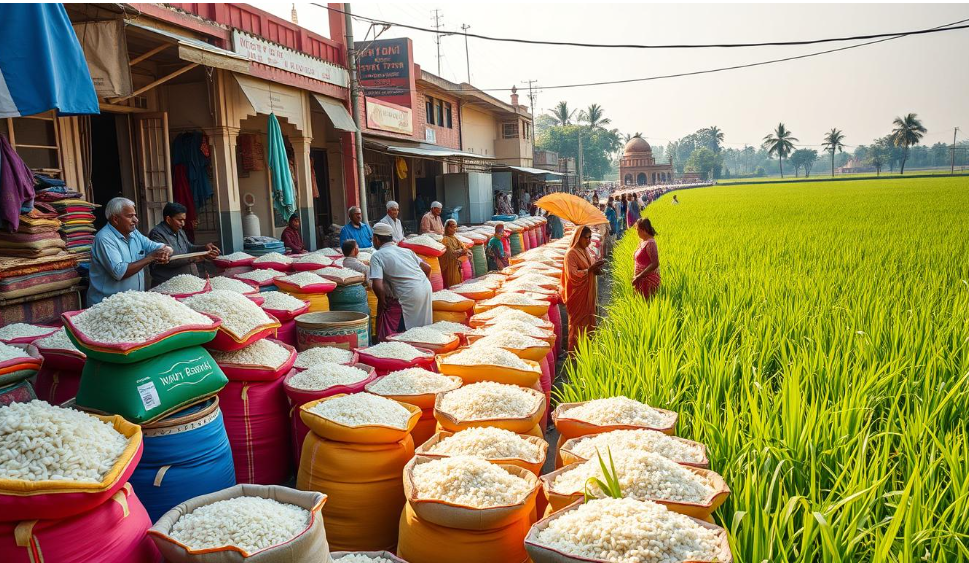India allows non-basmati white rice exports in boost for global supplies
The Government of India has made a big change. They are now letting non-basmati white rice be exported. This is because India has enough rice at home and wants to help the world.
Before, there were worries about how these exports would affect India. But now, they think it’s okay to send more rice out.
Key Takeaways
- India has lifted the ban on exporting non-basmati white rice to boost global supplies.
- The government’s decision is driven by a stable domestic rice supply and trade concerns over the previous export restrictions.
- The Agricultural and Processed Food Products Export Development Authority (APEDA) will monitor export contracts to ensure transparent pricing and prevent misclassification of non-basmati rice as basmati.
- The move is expected to provide relief to the global rice market, which has faced supply challenges in recent months.
- The decision aligns with India’s efforts to maintain a balance between domestic food security and international trade commitments.
India Lifts Export Ban on Non-basmati White Rice
The Indian government has made a big move to help the world’s rice supply. They have lifted the ban on exporting certain types of non-basmati white rice. This choice was made after talking to trade groups and checking the rice prices and supply in India.
Government’s Decision to Increase Exports
At first, a price of $1,200 per metric ton was set in August 2023. This was to keep rice prices in India from rising too high. It also helped stop non-basmati rice from being sold as basmati.
But, the price was then lowered to $950 per MT in October 2023. Now, the government wants to let some non-basmati rice be exported. They have enough rice stored and prices are stable. This move is to help more rice get to other countries and ensure everyone has enough to eat.
Domestic Rice Supply Stable and Prices Under Control
India’s basmati rice exports were $5.9 billion in the 2023-24 fiscal year. They exported 45.6 lakh tonnes of basmati rice in the 2022-23 year. The government also keeps a stock of onions to keep prices steady.
The area for growing onions has grown to 2.9 lakh hectares. This is more than the 1.94 lakh hectares in the last year. Farmers and traders have about 38 lakh tonnes of onions stored. This helps keep the supply and prices of rice stable in India.
“The government’s decision to lift the export ban on certain non-basmati rice varieties will help to increase global rice supplies and contribute to food security worldwide.”
India Allows Non-basmati White Rice Exports in Boost for Global Supplies
The Government of India has made a big change. They have lifted the ban on exporting non-basmati white rice. This move is expected to help with global rice supplies.
India is a big player in rice production and export. This decision will make more non-basmati white rice available worldwide. The ban on exporting this rice type was in place since July 20, 2023.
Even though a 20% export duty on parboiled rice will stay, this change is good news. India has planted more rice this year. The monsoon rains have also been strong, which means a good rice harvest.
This decision will help countries with food shortages. It will also make rice prices more stable globally. The Indian government is showing it cares about global food security and its role in the rice trade.
Monitoring and Transparency in Export Contracts
India has lifted the ban on non-basmati white rice exports. The government is making sure the export process is transparent and watched closely. The Agricultural and Processed Food Products Export Development Authority (APEDA) will be key in this effort.
APEDA will check export contracts to stop any wrong labeling or unfair prices on non-basmati rice. This is important to keep the quality of India’s rice exports high.
APEDA to Oversee Pricing and Prevent Misclassification
APEDA’s role is crucial for India’s non-basmati rice exports. They will watch over export contracts to make sure prices are fair. They also aim to stop non-basmati rice from being labeled as basmati.
This has happened before, causing problems in the market. APEDA wants to help farmers and exporters by making sure everything is fair. They also want to meet the needs of buyers around the world.
This effort will make India a trusted supplier of quality non-basmati rice. It will help the country grow its rice exports in a good way.
“APEDA’s oversight is crucial to maintain the integrity of India’s non-basmati rice exports and meet global demand effectively.”
The government is giving APEDA more power to help India’s rice exports grow. This shows their commitment to helping farmers and keeping the market fair.
Conclusion
India’s decision to let non-basmati white rice be exported is a big step. It’s expected to increase global rice supplies and keep prices stable. The government is working hard to make sure there’s enough rice for everyone at home and to control prices.
The Agricultural and Processed Food Products Export Development Authority (APEDA) is watching over rice exports. This shows India is serious about being a good global partner in the rice trade.
This move will make more rice available worldwide. Rice is a basic food for almost 3.5 billion people, especially in Asia. It will also help keep rice prices steady, helping both farmers and those who buy rice.
India is the second-biggest rice producer and the biggest exporter. So, this decision is very important for the global rice market.
India’s actions show how important it is to balance home needs with global duties. This is a positive step towards a more stable food system worldwide. It shows India’s important role in the global rice trade.
FAQ
What is the key decision made by the Government of India regarding non-basmati white rice exports?
The Government of India has decided to remove the floor price on its exports of non-basmati white rice. This is to enhance global supplies.
Why has the government made this decision?
The decision comes after dealing with trade concerns and a stable domestic rice supply. The government wants to boost global rice supplies and stabilize international rice prices.
How will the export of non-basmati white rice be monitored?
The Agricultural and Processed Food Products Export Development Authority (APEDA) will monitor export contracts. They ensure transparent pricing and prevent non-basmati rice from being misclassified as basmati during exports.
What was the previous export restriction on non-basmati white rice?
At first, a floor price of $1,200 per metric ton (MT) was set in August 2023. This was to address rising domestic rice prices and prevent misclassification. Later, in October 2023, this was reduced to $950 per MT.
What is the expected impact of this decision on global rice supplies?
India’s decision to remove export restrictions on non-basmati white rice is expected to boost global rice supplies. It will help ease global food shortages. As one of the world’s largest rice producers and exporters, this move will increase non-basmati white rice availability in the global market.
Powerful Helene cuts deadly path through Florida, southeastern U.S.











